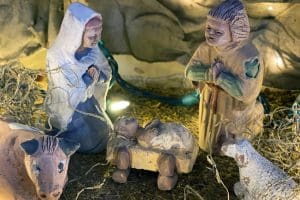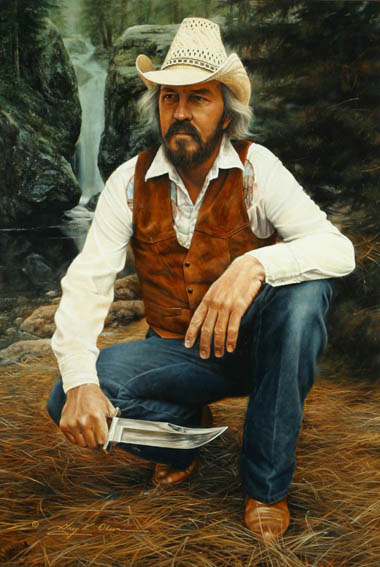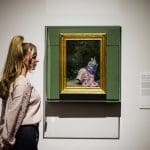![]()

By Steevun Lemon
Art by Greg Olsen
I remember the first time I saw a Greg Olsen painting. I was helping in Salt Lake City at the ReparteeGallery when I saw an examination proof of O Jerusalem. I was so taken with it that I told the owner I would work for free that weekend if she would give me the proof. She agreed and my journey with Greg Olsen had begun.
Interviewing Greg was an unforgettable experience and one that confirmed what the artwork had already shown me; no only is he a gifted artist, but also a wonderful person. He is the kind of person that you instantly feel comfortable around, a person truly without guile.
<!–click photo to enlarge
–>
Greg Olsen
How did you get interested in painting?
I grew up in a little farming town in Idaho called Iona. There weren’t a lot of things to do there for entertainment, so art became entertainment for me. I had a couple of cousins and uncles who drew and painted, and my mom was kind of a Saturday painter. She got together and painted with a group of ladies. They would go out in the fields, up along the streams and the canal banks. Apparently art is a defective family gene.
When did you get serious about art?
I always enjoyed doing art. Then in high school I had an excellent teacher, Mr. Whitney. He was very encouraging. He took us on art tours. We would come down to Utah, for example, and we would visit all of the university art departments. We also went to see some professional artists like Ed Fraughton, the sculptor. I thought he was amazing. I couldn’t believe that someone could actually feed his family making art.
Was Mr. Whitney your first art teacher?
No, I also had a great teacher in eighth grade, Mr. Longbourn He taught me the basics and most importantly, he made art fun. He was a beatnik kind of guy. And he had this attitude like, “Let’s just have a good time with art.” So it was my favorite class of the day. Then I had Mr. Whitney, who was… intense. You either loved him or you hated him. This was not a fun class. Well, no, it was fun. But he took it very seriously. His attitude was more, “If you’re not here to work hard, you’d better get out.” He was a scary guy. He was also the baseball coach and he could be intimidating. I didn’t dare turn in anything but my best work or he would rip it apart. He was very good at teaching the academics of drawing the figure. He made us feel like we were apprentices in a master’s workshop. I was a real groupie by my senior year. I had six art classes. He even built a little cubby hole in the corner of the art room where I could just hang out all day long. We became close friends.
Did you stay in touch with him?
Yeah. We’re still good friends. He teaches now in Downey, California and coaches golf on the side.
Who else has influenced you?
I have a cousin, Vince Bodily, who is three years older than I am. In high school, he was – from my point of view then – a full-blown professional artist. He had this amazing ability to draw and capture the likeness of a model. In 20 minutes, he would do an exquisite pencil drawing with a lot of flare and personality and character to it. He was my idol. During the summer, he would say, “Have you filled up your sketch books yet? Are you drawin’?” And I would feel guilty if I hadn’t been. He was a hero for me. He teaches at BYU-Idaho now and, like Mr. Whitney; he is serious about what he does.
Who else?
Well, my exposure to other artists was fairly limited in Iona. It’s not a cultural center by any means. So I grew up seeing what was immediately available – the Saturday Evening Post Covers from Norman Rockwell, book covers by Charlie Russell, Fredrick Remington and the other western artists. These were the artists that I was exposed to. I also liked Maxwell Parish for some reason. His old calendars interested me. Visiting an art gallery for me was going to the book store and looking at the paperback book covers. I didn’t even know who painted most of those. But I have always been fascinated by so many different styles.
When did you decide on art as a career?
I started thinking about it seriously in high school. Then I studied illustration at Utah State. For a while I was planning on going off to New York or Los Angeles and becoming a great illustrator. That is what I wanted to do. But I ended up leaving school and working as an in-house illustrator for a business in Salt Lake City called the Exhibit Company. They did all kinds of exhibits – trade shows and museum visitor centers and other things like that. I did whatever they wanted, from murals to silk screening and lettering. I did that for about a year and a half before I decided to jump out on my own.
When was that?
About ’81. I had a friend who talked me into it. Well, he didn’t talk me into it, but he planted the seed. He said, “If I know you Greg, what you really would like to do is just be out on your own, painting.” To which I responded, “Well…yeah.” He said to me, “Well, it’s not going to get any easier.” We had one little baby then. Our car was paid for and our rent was about $150 a month. He convinced me that it was only going to get harder. So we thought about it a lot, and finally decided to go for it. I quit my job. We framed up all my old college art projects and I painted for a couple of months while we lived off our savings. Then at the end of this period, we had a big grand opening art show to kick off my new freelance career.
This friend who had persuaded me to leave my job came from a wealthy family. They had a beautiful home in which they offered to host this show for us. They worked really hard calling up all their friends and I am sure saying, “Would you please come and see this kid’s stuff? Just be a body here in our house that night.” So they had a great crowd. We had nice refreshments and we had printed up beautiful invitations. But when the night was over, we had sold enough to pay for those refreshments and, I think, most of the invitations.
I was left thinking, “Oh no. What have I done?!” There was a week of mourning after that grand opening show before somebody who had been there that night called us. They said, “We didn’t really like anything at the show, but would you do a commission for us?” “You bet! Sure.” That commission got us by for a month or two. And it went like that for the next ten or twelve years. We pretty much lived from painting to painting.
What was the first piece you sold?
The first piece I ever sold was actually back in high school. I sold it to the principal of our HS. It was a great big landscape.
And what did it go for?
I think it was for $125. And I was just so excited I blew the whole wad. I bought a stereo.
When did you switch from landscapes to religious subjects?
Well, I didn’t really switch. Maybe I just have a short attention span, but I really have a hard time pigeon-holing myself and doing only one thing. I just like lots of different subjects. I’m kind of like a musician who likes country music and jazz and everything else.
How do you choose your subject matter?
The ideas come in a variety of ways I can’t say that they happen in any kind of formulated manner. Sometimes things will come – BAM! – in one complete idea, and other times they evolve from one thing into another. I try to record ideas as they come along. I have a little notebook that I carry around with me. As I get ideas, I will jot down a one sentence idea, or I will draw a little thumbnail sketch to remind me of a particular thought.
When they come to me, I think that I will remember them. But when I go back and read this notebook, I am amazed. I think “Oh yeah, I forgot about that.” Or “I don’t remember ever even thinking of that.” It is almost like someone else wrote it. So when it is time to do a new piece, I will go through my notebook. Certain ideas will percolate to the top, and I’ll get more excited about one than another and that is what I paint.
What motivates you to paint?
A number of things. My family and children paintings are a form of journaling for me. My mom was great at keeping journals and it is so fun to go back and read things that she wrote. I am awful at keeping journals. So this is kind of my way of recording my life. Our kids are in a lot of the paintings. And I guess that is sort of selfish. But it part of my life. We have five girls and one son. There is a lot of… estrogen stuff going on around our house. So even though some of the paintings are a little sappy and sentimental, it is just what happens around the house. That is one motivation.
As for the inspirational pieces, I think artists have been drawn to that kind of challenging subject matter for centuries. And again, it is a part of who I am.
<!–























